
1. Ultimately derogatory portrayals can demoralize and reduce self-esteem.
2. Reasons for this unfair portrayal
2.1. Stereotypes | People who have never interacted with a black family in their communities more easily embrace what the media tells them.
2.1.1. The African Americans in countries where society paints them negatively, become victims of perception – public perception, which then influences their self perception and self-affirmation. These people are susceptible to internalising biases and stereotypes
2.2. Lack of Black Presence in the Media | There is a significant under representation of African Americans when it comes to the ownership of media
3. Effect of this Unfair Portrayal
3.1. Negative mass media portrayals are strongly linked with lower life expectations among black men.
3.2. African American men are seen as being synonymous with criminality and violence
3.3. Public has less empathy for African Americans in trouble, government and societal help comes at a lesser priority.
3.4. Public and government place less attention and importance to the bigger picture of the socio-economic disparity of African Americans and thus public support of brutality and inequality (e.g. police aggression, longer jail sentences) this entire cultural population faces is limited.
3.4.1. The public perspective influences the judgement of the worse people | - Judges hand out harsher sentences, - Companies deny jobs, - Banks decline loans - and the police to shoot indiscriminately. The mass media is certainly aware of its vast power to shape popular ideas, opinions and attitudes and yet the change to a more equal society is happening at too slow a rate. Lives are being devastated due to media portrayal.
4. Various media outlets such as TV shows, newspapers, exaggerated associations of African-Americans to drug-related crime, unemployment and poverty.
4.1. From 1955 to 1986 only 6 percent of the characters were African-Americans, while 89 percent of the TV population was white.
4.2. Media overwhelmingly depicted black families as poor and dependent on welfare, black fathers as absent, and consistently overhyped the link between black families and criminality. However, when it comes to white families, the picture painted is often of social stability.
4.2.1. This is contrary to the actual situation. In the US, black families represent 59% of the poor in the media, but make up just 27% of the poor of the general population, says the study. White families, on the other hand, represent 17% of the poor in media, but make up 66% of the poor across the country.
4.2.2. Media reports suggest black men often abandon their children and families
4.2.2.1. This falsely leads to the public assumption that Black fathers who are not married to the mothers of their children must not be involved parents.
4.2.2.1.1. But a 2013 report by the Centre for Disease Control found that black fathers were more likely to: - have bathed, dressed, or helped their children use the toilet every day compared with white fathers; - black fathers were more likely to take their children to or from activities every day compared with white fathers; - have helped their children with homework every day in the last four weeks compared with white fathers.
4.3. There is a stereotype called “welfare queens”— that presents black women as having children only to receive welfare assistance from the government, when actual they may simply be having children for the miracle of having them.
4.3.1. This led to the perception that black people not only benefited the most from government aid, but were far more likely to cheat the system than white people.

